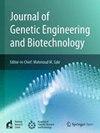NAR纳米颗粒通过G蛋白偶联受体91信号、TRAP1和SIRT3调控SDHA在肺癌细胞中的释放
IF 2.8
Q3 Biochemistry, Genetics and Molecular Biology
Journal of Genetic Engineering and Biotechnology
Pub Date : 2025-02-11
DOI:10.1016/j.jgeb.2025.100464
引用次数: 0
摘要
癌细胞表现出氧化代谢失调以满足其生物能量需求。具体来说,我们努力调节代谢物琥珀酸及其作为肿瘤侵袭和转移诱导剂的负面作用。方法通过分子对接研究柚皮素(NAR)与线粒体复合体II (CΙΙ)亚基、sirtuin3 (SIRT3)、肿瘤坏死因子相关蛋白1(TRAP1)、琥珀酸受体(SUCNR1)的结合亲和力。合成了NAR纳米颗粒(NARNPs),并通过IR、x射线、UV、药物释放、zeta电位、TEM和SEM对其进行了表征。采用MTT技术测定正常小鼠、正常成纤维细胞和A549细胞的IC50。此外,我们还评估了抗5-FLU的NAR和NARNPs对CΙΙ活性、SOD活性和线粒体肿胀的影响。用流式细胞术检测细胞凋亡。RT-qPCR检测相关基因SDHC、D、SIRT-3、TRAP1、SUCNR1、ERK1/2基因的表达情况。Western blot检测PI3K、NF-κB对β-actin的影响。结果从理论上讲,NAR &;SDHC、D、SIRT-3、TRAP1和SUCNR1蛋白较强。评估了NAR和NARNPs的细胞毒性作用。与正常细胞株相比,A549细胞对SDH C、D活性的抑制程度更高,对B活性的抑制程度更高(NARNPs <;NAR & lt;伴有SDH C、D、TRAP1、SUCNR1、ERK1/2基因表达下调,SIRT-3基因表达上调。NF-κB和PI3K蛋白表达下降。另一方面,随着线粒体的扩大,凋亡效应显著增加(NARNPs >;NAR祝辞5-FLU)在A549中的表达与正常细胞相比。综上所述,SDH调控琥珀酸盐与NARNPs调控SUCNR1信号将是一种新的认识机制和肺癌治疗的候选靶点。本文章由计算机程序翻译,如有差异,请以英文原文为准。

Management succinate release through SDHA by G protein-coupled receptor 91 signal, TRAP1, and SIRT3 regulation in lung cancer cells by NAR nanoparticles
Background
Cancer cells display oxidative metabolic dysregulation to fulfill their bioenergy requirements. Specifically, efforts were made to regulate the metabolite succinate and its negative effects as an inducer for neoplasm invasion and metastasis.
Methods
Binding affinity of naringenin (NAR) to mitochondria complex II (CΙΙ) subunits, sirtuin3 (SIRT3), tumor necrosis factor associate protein 1(TRAP1), and succinate receptor (SUCNR1) was studied by molecular docking. NAR nanoparticles (NARNPs) were synthesized and characterized by IR, X-ray, UV, drug release, zeta potential, TEM, and SEM. The IC50 was evaluated in normal mice, normal fibroblast, and A549 cells by using the MTT technique. Moreover, the impact of NAR and NARNPs against 5-FLU on CΙΙ activity, SOD activity, and mitochondrial swelling was assessed. Apoptosis was also assessed using the flow cytometry method. While the expression of relevant genes such as SDHC, D, SIRT-3, TRAP1, SUCNR1, and ERK1/2 genes was determined by using RT-qPCR analysis. Western blot evaluated PI3K, NF-κB against β-actin.
Results
Theoretically, the binding affinity between NAR & SDHC, D, SIRT-3, TRAP1, and SUCNR1 proteins was stronger. Cytotoxic effects of NAR and NARNPs were evaluated. Also, the activity of SDH C, and D was inhibited more than SDH A, and B activity in the A549 than normal cell lines (NARNPs < NAR < 5-FLU), This was accompanied by downregulation of SDH C, D, TRAP1, SUCNR1, and ERK1/2 genes expression, and upregulation of SIRT-3 gene expression. Additionally, NF-κB and PI3K protein expression declined. On the other hand, there was a significant increase in apoptotic effects with mitochondria enlargement (NARNPs > NAR > 5-FLU) in A549 compared with normal cells.
In conclusion
Controlling succinate by SDH parallel with SUCNR1 signal regulation by NARNPs will be a novel understanding mechanism and candidate for therapeutic target in lung cancer.
求助全文
通过发布文献求助,成功后即可免费获取论文全文。
去求助
来源期刊

Journal of Genetic Engineering and Biotechnology
Biochemistry, Genetics and Molecular Biology-Biotechnology
CiteScore
5.70
自引率
5.70%
发文量
159
审稿时长
16 weeks
期刊介绍:
Journal of genetic engineering and biotechnology is devoted to rapid publication of full-length research papers that leads to significant contribution in advancing knowledge in genetic engineering and biotechnology and provide novel perspectives in this research area. JGEB includes all major themes related to genetic engineering and recombinant DNA. The area of interest of JGEB includes but not restricted to: •Plant genetics •Animal genetics •Bacterial enzymes •Agricultural Biotechnology, •Biochemistry, •Biophysics, •Bioinformatics, •Environmental Biotechnology, •Industrial Biotechnology, •Microbial biotechnology, •Medical Biotechnology, •Bioenergy, Biosafety, •Biosecurity, •Bioethics, •GMOS, •Genomic, •Proteomic JGEB accepts
 求助内容:
求助内容: 应助结果提醒方式:
应助结果提醒方式:


